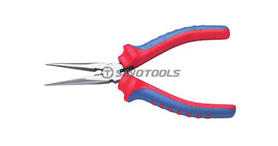

Oct. 23, 2020
 Pliers are used to clamp, position, tighten, loosen and cut certain metal components. China Cutting Pliers Manufacturers introduces you to five types of pliers: sliding joints, water pumps, linemen, locks and sharp noses.
Pliers are used to clamp, position, tighten, loosen and cut certain metal components. China Cutting Pliers Manufacturers introduces you to five types of pliers: sliding joints, water pumps, linemen, locks and sharp noses.
Sliding pliers
Sliding pliers are tools called pliers that I first learned. Only later did I discover that there were more types of pliers than the children nearby.
Pliers are not a high-precision tool, but even when I was a boy, I still found that pliers can help with many daily tasks in the house, whether it's fixing a bicycle, a kitchen stool or a little wiring. They are very suitable for fixing or bending flat or round materials, crimping sheet metal, winding wire, cutting soft metal nails, removing split pins, and loosening or tightening nuts when necessary.
The key to the versatility of this tool is the sliding joint that gives the pliers its name. Like most pliers, they are operated by opening and closing the handle, which creates the opening and closing action of the jaws. However, another advantage of flat-nose pliers is the adjustable pivot point, which allows the two parts of the jaw to move relative to each other. Therefore, depending on the size of the pliers, a pair of non-slip pliers can be used to firmly grip objects ranging in thickness from a single sheet of paper to half an inch or more. Most sliding pliers have two or three options to locate the pivot point.
The jaws of the pliers are flat and serrated at the mouth, but are bent behind the jaws near the pivot. This curved area was once called the burner handle because it was originally used to remove the nozzle from the gas lamp, and it would hold round objects such as pipes or rods. Many sliding pliers are still behind the curved serrations, and there are wire cutters built into the neck of the pliers.
Water pump pliers
This set of pliers has multiple variations on the same subject. These tools are sold in the design of arc pliers, channel locking pliers (proprietary name), and are designed to hold pipes. The jaws are at an angle to the length of the handle, so it can easily enter between the joists and enter the awkward space.
Pump pliers are not the only plumber because they have many other uses.
The jaws of the water pump pliers are serrated and arc-shaped. Like flat-nose pliers, they can be adjusted to grasp objects of various sizes. The pivot point on the arc joint model moves similarly to the pivot point on the sliding joint pliers, while on other joints, there are a series of grooves that make the jaws at different openings, but make the pliers The mouths are parallel to each other. Varieties with channel design can better grasp pipes or other objects. The jaws can be set in seven different positions on many plumber pumps.
Linesman's Pliers
Sometimes called electrician pliers or engineer pliers (the latter are usually sold without insulated handles), these are very versatile steel tools. Linesman's pliers are descendants of tools called "Bell pliers" in the 19th century because they were used by bell hangers to cut and twist wires used to connect non-electrified household clocks.
Like other pliers, they are hinged on a pivot point, so operating the handles together or separately will cause the jaws to close or open. The jaws have shallow serrations and can be held firmly, especially for flat objects such as sheet metal, which can explain their popularity among sheet metal workers. Electricians rely on jaws to twist the wires into a conical knot, which is then protected by a plastic insulator called a wire nut. Behind the jaws are a pair of side knives for cutting metal wires. Using them to cut nails will quickly become dull.
Although the pliers sold are available in various sizes, ranging from 5 to 10 inches in length, the 8-inch size can meet most needs. Buy a pair with plastic handles, but remember that plastic alone is not enough to protect you from electric shock. Do not use these tools or any other tools on live wires. Before doing any electrical work, be sure to remove the fuse, turn off the circuit breaker, and unplug the power cord.
Locking pliers
These adjustable pliers are designed to be used as a handheld vise or clamp that is firmly locked on the workpiece. Also known as pliers wrenches, lever pliers, and named after the proper name Vicecraps, they have double leverage.
Like other pliers, by squeezing the handles together, their jaws are closed. However, the opening of the jaws is adjusted by rotating the screwdriver in a handle, and when the jaws touch the object to be grasped, the increased pressure will lock it in the vise-like handle. To release the grip of the tool, the lever in the other handle will be triggered. The compound leverage of this tool means that the jaws can exert tremendous force.
Locking pliers are manufactured in several different configurations and sizes. Most jaws are serrated, straight, and vary in length from 4 to 12 inches. Models with curved jaws are also sold, as well as long nose, flat mouth, flat mouth and C-clamp configurations. Multifunctional locking pliers can replace pipe wrenches, adjustable wrenches, and even pliers.
As with other types of pliers, it is rarely necessary to use locking pliers on nuts, bolt heads, pipes or fittings to be reused. The serrated teeth on most locking pliers will permanently damage the parts they hold.
Needle nose pliers
These are essentially small electrician pliers with long, pointed jaws. Needle-nose pliers are smaller in size than wire pliers and are especially suitable for using wires in narrow spaces (such as electrical boxes), although they can also be used to bend and fix metal fittings. Their jaws gradually become thinner and have serrations on the gripping surface of their noses. There is a side knife at the throat of the tool near the pivot.
Sometimes called a radio pliers, this tool can also be used to handle small nuts, washers, or other parts that require precise placement, which may not be reachable by fingers. Needle-pointed pliers can be purchased, the pointed end of which is bent at a 45-degree or 90-degree angle to the handle line.
When using needle-nose pliers, remember that they are not for heavy work. They are precision tools, and if abused, their jaws may bounce, bend or break. Use them for temporary work that is required, not for more demanding tasks.
Our company provides high quality China Cutting Pliers. If you are interested in our products, please feel free to contact us.
Latest Post
SINOTOOLS Showcases Popular Hand Tools at the 138th Canton Fair
SINOTOOLS successfully participated in the 138th Canton Fair, showcasing high-quality hand tools and connecting with global clients. Booth No. 13.1H27, Guangzhou, China.
Oct. 21, 2025
Reflecting on Our Journey at Japan DIY Homecenter Show 2025
From August 21st to 23rd, our team had the pleasure of attending the Japan DIY Homecenter Show 2025, held in Chiba, Japan.
Aug. 25, 2025